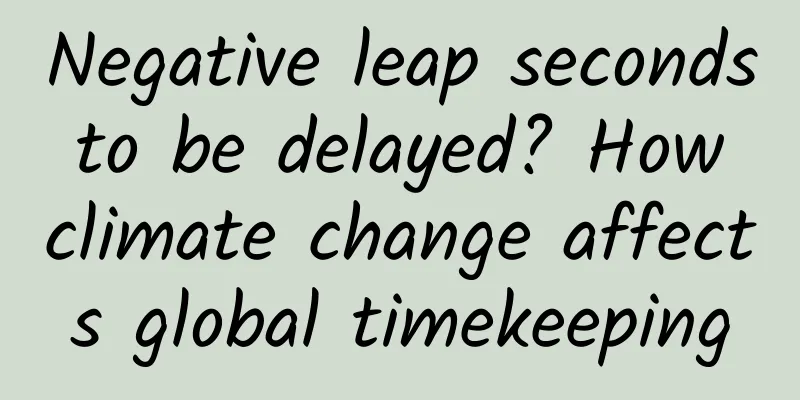Negative leap seconds to be delayed? How climate change affects global timekeeping

|
Dou Zhong, Deputy Director, National Time Service Center, Chinese Academy of Sciences Recently (March 27, 2024), the British journal Nature published an article stating that climate change has slowed down the Earth's rotation and affected global timekeeping. The article believes that in recent years, due to changes in the Earth's core, the Earth's rotation speed has suddenly increased, and it is possible that the first "negative leap second" in human history will occur. However, climate warming has accelerated the melting of the Earth's polar ice caps, slowing down the Earth's rotation speed, which may lead to the postponement of the "negative leap second". What is going on? What does the appearance or delayed appearance of “negative leap seconds” have to do with us? What is a leap second? Why are they positive or negative? There are two commonly used timekeeping systems in the world, namely the Universal Time (UT1) based on the rotation of the earth and the International Atomic Time (TAI) based on the atomic oscillation period. Due to the unevenness of the earth's rotation speed, there will be a time difference between the two timekeeping systems over time, so the concept of "Coordinated Universal Time" (UTC) came into being. "Coordinated Universal Time" is based on the length of the second of the International Atomic Time and is as close to the world time as possible in terms of time. When the predicted time difference between the Coordinated Universal Time (UTC) and the World Time (UT1) exceeds 0.9 seconds, a full second adjustment is given to the Coordinated Universal Time, which is a leap second. Figure 1: Inserting leap seconds into International Atomic Time gives us Coordinated Universal Time. A positive leap second is when Coordinated Universal Time is moved back by 1 second (adding 1 second), or moved forward by 1 second (subtracting 1 second) is a negative leap second. Figure 2: Positive and negative leap seconds Since the birth of Coordinated Universal Time (UTC) in 1972, a total of 27 leap seconds have been implemented, all of which are positive leap seconds, and negative leap seconds have never been used. In other words, in the past 52 years, the Earth's rotation rate has been slowing down relative to the atomic time rate, and the rule is roughly "two leap seconds every three years." But it is not necessarily the case. For example, there was no leap second for 7 years from 1998 to 2005, and there has been no leap second since 2017, which shows that the Earth's rotation rate did not continue to slow down during these two periods. Figure 3: Since 1958, the difference between Coordinated Universal Time and International Atomic Time has been 37 seconds; since 1972, there have been 27 leap seconds, all of which were positive leap seconds. Why does polar ice melting delay the arrival of "negative leap second"? Affected by factors such as tides, the Earth's rotation has been in a long-term slowing trend, so all leap second adjustments to date have been positive leap seconds. Duncan Agnew, a geophysicist at the Institute of Oceanography at the University of California, San Diego, used satellite data to study the impact of the Earth's rotation rate and the movement of the Earth's core. He said that in recent years, the angular velocity of the liquid part of the Earth's core has continued to decrease at a constant rate of change, which has led to an increase in the angular velocity of the rest of the solid part of the Earth. Under the influence of this effect, if the melting of the poles is not taken into account, the Earth may need the first negative leap second adjustment as early as 2026. Figure 4: Curve of the difference between the measured Universal Time UT1 and the Coordinated Universal Time UTC for 52 years from 1972 to the present. This is the curve of the measured UT1 and Coordinated Universal Time UTC difference for 52 years from 1972 to the present. As can be seen from the figure, dUT1 (the difference between UT1 and UTC) has been downward for half a century. When it is close to 0.9 seconds, the International Earth Rotation Service (IERS) will start the leap second in time according to the trend of the curve (pull back 1 second on the curve). There have been 27 leap seconds in these 52 years, all of which are "positive leap seconds". However, since mid-2020, this curve has indeed reversed its trend, and it is possible to trigger the first "negative leap second" in history in the next few years. However, in recent decades, due to the accelerated melting of ice in Greenland and Antarctica, part of the Earth's mass has moved from the poles to the equator, which has caused the Earth's rotation speed to slow down. This is similar to how figure skaters speed up their rotation when they raise their arms above their heads, and slow down their rotation when they extend their arms from their heads to their sides. Affected by this, Agnew predicts that the first negative leap second adjustment may be postponed to 2029. What impact do negative leap seconds have on us? Global warming affects the change in the Earth's rotation rate, which is closely related to Universal Time (UT1). Global warming causes the polar ice caps to melt faster, and part of the Earth's mass is transferred from the poles to the equator, causing the angular velocity of the solid Earth to slow down faster than before. This will directly lead to a longer second in Universal Time (UT1), thus affecting the frequency of leap seconds, and further affecting the international standard time - the leap second of Coordinated Universal Time. Universal Time (UT1) is a time scale based on the rotation of the Earth and is an important parameter in the national standard time. Universal Time measurement service is a basic service necessary for timekeeping, satellite navigation, deep space exploration and high-precision astrometry. In recent years, the National Time Service Center has established a universal time measurement system based on the VLBI measurement system and the Zenith Camera Telescope. By integrating the UT1 of broadband VLBI and the day length changes of the International GNSS Monitoring and Assessment System (iGMAS), it has initially realized the autonomous measurement and data service of universal time with an accuracy of 100, which can initially meet the needs of various tasks in my country. In recent years, the abolition of leap seconds has caused widespread controversy, given that leap seconds will have a certain impact on the operation of communications, navigation, networks, etc. that require continuous timing. Every international conference related to it has difficulty reaching a consensus due to insufficient arguments on the pros and cons of retaining or canceling leap seconds, and the lack of a clear and safe transition plan after the abolition of leap seconds. The issue was discussed again at the 27th General Conference on Weights and Measures in 2022, and the conference concluded that leap seconds should be abolished no later than 2035. All parties were asked to negotiate and propose a new plan that could keep "Coordinated Universal Time" for at least a hundred years, perhaps a "leap minute." The meeting decided to strive to give the final difference between UTC and UT1 at the 28th General Conference on Weights and Measures in 2026, and gradually discuss the technical transition plan for time applications after the abolition of leap seconds. Given the work that the National Time Service Center has achieved in terms of world time autonomy, and with more than a decade of efforts, whether or not the leap second is abolished in 2035 will not affect my country's economic and social development and national security. Before leap seconds are abolished in 2035, the first and last "negative leap second" in human history may occur. Let's wait and see. The arrival of "negative leap seconds" may bring challenges to computer systems around the world. Agnew said: "No one has noticed this problem before, because computer systems only face the situation of "positive leap seconds". No one can really predict the arrival of "negative leap seconds", so we can't estimate the scale of the chaos we are about to face." This article is a work supported by Science Popularization China Starry Sky Project Author Name: Dou Zhong Reviewer: Gao Zhe National Time Service Center, Chinese Academy of Sciences Produced by: China Association for Science and Technology Department of Science Popularization Producer: China Science and Technology Press Co., Ltd., Beijing Zhongke Xinghe Culture Media Co., Ltd. |
>>: As early as 60,000 years ago, did Australian people achieve "nut freedom"?
Recommend
FCA's smallest North American assembly plant will close next month, and Dodge Viper production will cease
According to foreign media reports, FCA said it w...
WOT2016 Liu Ziqian: Yunti is the defender of Internet security
Dr. Liu Ziqian , CISSP , is a visiting scholar at...
The peak season for flying catkins has arrived! Quickly collect the protection guide for children
April is the time when spring flowers bloom and w...
A female Trump appeared in France and wanted to force the car companies to return to their factories
According to foreign media reports recently, Fren...
Surprise! The rosy strawberries don’t taste sweet at all? The reason is…
Many people like to eat strawberries, and I like ...
I fell in the metaverse, it hurts so much!
The baby left the mother's body and came into...
How to explore user needs? Follow these 5 steps!
We are always asked to explore user needs. How do...
Can smelly car exhaust be made “cleaner”?
Too many cars on the road will not only cause tra...
Foreign media: Apple's performance in 2016 was really not very good
According to foreign media reports, after a one o...
A comprehensive collection of Xiaohongshu operation tools!
If you want to do your work well, you must first ...
How to achieve 100,000 downloads in 2 months with zero budget for APP operation and promotion?
For promoters, the most difficult time is the fir...
Comment traffic generation is very effective, just follow it stupidly!
People working in the Internet industry are often...
Disappointing: Apple Watch's sapphire screen is so bad
The low production volume is only one of the reas...
BMW wants to keep things simple to offset R&D costs
According to foreign media reports, BMW Chief Fin...
Why is this tree's belly so round? Uncovering the "water storage legend" of South African plants
Have you heard of the "water storage legend&...









